Vagrant Species Part 3
Issue date: 6th October 2022
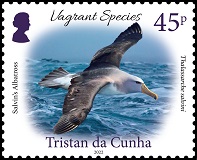 |
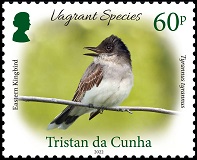 |
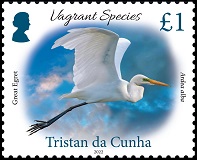 |
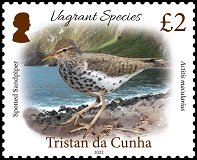 |
| 202213 | Mint Stamps (45p, 60p, £1.00, £2.00) | £4.05 | Shop > |
| 202214 | First Day Cover (with 45p, 60p, £1.00, £2.00 stamps) | £5.25 |
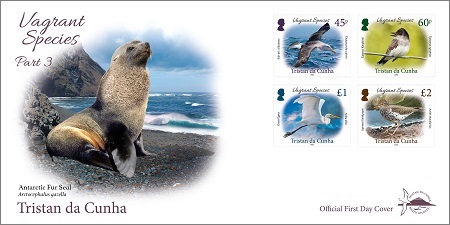
Tristan da Cunha lies in the middle of the South Atlantic Ocean, east of the mid-Atlantic ridge, 2,800km from the continental shores South Africa, and 3,360km from South America. It is the most remote island in the world with a resident human population, with St. Helena, the nearest island some 2,400km away. Vagrant species might seem to be a curiosity, but all of the native animals on Tristan arose from individuals that wandered far from their usual haunts.
45p - Salvin's Albatross (Thalassarche salvini) - Salvin's Albatross or Salvin's Mollymawk, is a large seabird about 90 cm (35 in) long and with a wingspan of 2.5 m (9 feet). It is closely related to the White-capped Albatross, which is a more regular visitor to Tristan's waters.
Salvin's Albatrosses mainly breed on the Bounties and Snares, groups of small rocky islands with little vegetation south of New Zealand. At sea they mostly range across the South Pacific to winter in the Humboldt Current off the west coast of South America, but some birds wander more widely, occasionally reaching South Africa. The species has not been recorded at sea around Tristan or Gough, but there are a couple of records of adults ashore in Atlantic Yellow-nosed Albatross colonies on Gough Island. They might be prospecting for new breeding opportunities because a few pairs breed among other mollymawk colonies on two islands in the Crozet Archipelago, southeast of Africa.
The nest is a pedestal made of mud, feathers, and bird bones. A single egg is laid in September, and incubated by both parents until early November. The chicks fledge after about 4 months. They mainly feed on fish and cephalopods, and often scavenge scraps from fishing boats.
60p - Eastern Kingbird (Tyrannus tyrannus) - The Eastern Kingbird is a large tyrant flycatcher native to the Americas. Adults are dark grey above with a blackish head and white underparts. They have a long blackish tail with a broad white tip and long, pointed wings. Eastern Kingbirds breed across much of North America in the northern summer, then migrate south to winter in Central and northern South America. Some travel farther south to Uruguay and northern Argentina, and a few stragglers reach Patagonia and the Falkland Islands. There has been only one record from Tristan, and it remains the only songbird (passerine) confirmed to have reached the islands. Other possible songbirds have been sighted, but not identified.
Eastern Kingbirds are largely insectivorous, but they also eat berries and fruit, mainly in their wintering areas. Most insects are caught in flight; the Kingbirds wait on an exposed perch for insects to fly past, then sally out to catch them. They sometimes hover to pick prey off vegetation before returning to their perch. Eastern Kingbirds usually lay 3 eggs in an open cup nest built by the female on a horizontal branch in a tree canopy. The chicks leave the nest 2.5 weeks after hatching, but continue to be fed by the parents for 3-4 weeks after fledging.
£1 - Great Egret (Ardea alba) - The Great Egret is a large, white heron with an impressive wingspan, much larger than the more common vagrant Cattle Egrets that regularly arrive on Tristan. They are sometimes known as White Herons, because although their white plumage makes them look like egrets, they are in the same genus as the Ardea herons, and only slightly smaller and more graceful than Grey or Great Blue Herons. Great Egrets hunt in classic heron fashion, standing immobile or wading through wetlands to capture fish with a deadly jab of their yellow bill.
These majestic birds are one of the most widespread herons in the world, with populations in the Americas, Africa, Eurasia and Australasia. The Great Egrets spotted on Tristan probably are young birds, dispersing from their natal colony. They could come from either Africa or South America, but given the prevailing westerly winds they are more likely to have been blown off course from South America. Like most vagrants that reach Tristan, they probably eventually fly out to sea in the hope of finding a more suitable home.
Great Egrets fly slowly but powerfully: with just two wingbeats per second their cruising speed is around 25 miles an hour. They breed in colonies called heronries, often in association with other herons, egrets and other waterbirds such as ibises and cormorants. Aggression among nestlings is common and large chicks frequently kill their smaller siblings. Great Egrets were hunted nearly to extinction for their plumes in the late nineteenth century, sparking conservation movements and some of the first laws to protect birds.
£2 - Spotted Sandpiper (Actitis macularius) - The Spotted Sandpiper is a small shorebird that breeds in North America and migrates to Central and South America in the northern winter. It is closely related to the Common Sandpiper, which replaces it in Eurasia. Adults have short yellowish legs and an orange bill with a dark tip. The body is brown on top and white underneath with black spots.
Unlike the Common Sandpiper, it is usually polyandrous; most females mate with and lay clutches for more than one male, leaving incubation to them. As a result, their eggs are smaller than those of the Common Sandpiper. Male Spotted Sandpipers incubate the eggs for about 20–23 days, and care for the chicks once the eggs hatch. Adults forage on insects, crustaceans and other invertebrates as well as small fish and carrion, which they pick from the ground or in shallow water. Vagrants have been recorded from the main island of Tristan on several occasions, usually feeding along the coast near Edinburgh of the Seven Seas.
FDC - Antarctic Fur Seal (Arctocephalus gazella) - The Antarctic Fur Seal is one of eight fur seals in the genus Arctocephalus, and is closely related to the common, resident Subantarctic Fur Seal A. tropicalis that breeds at Tristan and Gough Island. As its name suggests, the Antarctic Fur Seal has a more southerly distribution, breeding at islands off the Antarctic Peninsula and South Georgia as well as sub-Antarctic islands east to Macquarie, south of New Zealand. The two species breed together on the Prince Edwards, Crozets and Macquarie. Only occasional young Antarctic Fur Seals reach Tristan and Gough, although they also wander to South Africa.
Antarctic fur seal females grow to about 1.45 m long and weigh up to 50 kg. Adult males are considerably larger, up to 2 m long and 230 kg. Uniformly dark brown to charcoal, the neck and chest are silvery-grey with longer guard hairs on the mane. Females and juveniles are grey dorsally with creamy throat and chest, with a light blaze on the flanks. Pups are black at birth, and moult to silver-grey colouring when they are 2 to 3 months old. Antarctic fur seals have a wide distribution near the Antarctic Convergence in the Southern Ocean. Most of them breed on South Georgia but they also breed on other sub-Antarctic islands. When at sea they disperse widely, spending much time in the ocean hunting for food. On land, they haul out on beaches which vary from sand, shingle and cobbles to vegetated areas, depending on the island locality.
Technical Specifications from Pobjoy Mint Ltd.
| Designer: | Andrew Robinson | Stamp size: | 30.6 x 38mm |
| Printer: | Cartor Security Printing | Perforation: | 13¼ x 13 per 2cms |
| Process: | Stochastic Lithography | Layout: | 10 |
| Production Co-ordination: | Creative Direction (Worldwide) Ltd |
